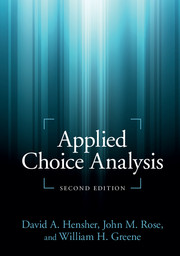Book contents
- Frontmatter
- Contents
- List of Figures
- List of Tables
- Preface
- Part I Getting started
- Part II Software and data
- Part III The suite of choice models
- 11 Getting started modeling: the workhorse – multinomial logit
- 12 Handling unlabeled discrete choice data
- 13 Getting more from your model
- 14 Nested logit estimation
- 15 Mixed logit estimation
- 16 Latent class models
- 17 Binary choice models
- 18 Ordered choices
- 19 Combining sources of data
- Part IV Advanced topics
- Select glossary
- References
- Index
14 - Nested logit estimation
from Part III - The suite of choice models
Published online by Cambridge University Press: 05 June 2015
- Frontmatter
- Contents
- List of Figures
- List of Tables
- Preface
- Part I Getting started
- Part II Software and data
- Part III The suite of choice models
- 11 Getting started modeling: the workhorse – multinomial logit
- 12 Handling unlabeled discrete choice data
- 13 Getting more from your model
- 14 Nested logit estimation
- 15 Mixed logit estimation
- 16 Latent class models
- 17 Binary choice models
- 18 Ordered choices
- 19 Combining sources of data
- Part IV Advanced topics
- Select glossary
- References
- Index
Summary
In mathematics you don’t understand things. You just get used to them.
(John von Neumann, 1903–57)Introduction
The majority of practical choice study applications do not progress beyond the simple multinomial logit (MNL) model discussed in previous chapters. The ease of computation, and the wide availability of software packages capable of estimating the MNL model, suggest that this trend will continue. The ease with which the MNL model may be estimated, however, comes at a price in the form of the assumption of Independence of Identically Distributed (IID) error components. While the IID assumption and the behaviorally comparable assumption of Independence of Irrelevant Alternatives (IIA) allow for ease of computation (as well as providing a closed form solution), as with any assumption violations both can and do occur. When violations do occur, the cross-substitution effects (or correlation) observed between pairs of alternatives are no longer equal given the presence or absence of other alternatives within the complete list of available alternatives in the model (Louviere et al. 2000).
The nested logit (NL) model represents a partial relaxation of the IID and IIA assumptions of the MNL model. As discussed in Chapter 4, this relaxation occurs in the variance components of the model, together with some correlation within sub-sets of alternatives, and while more advanced models such as mixed multinomial logit (see Chapter 15) relax the IID assumption more fully, the NL model represents an excellent advancement for the analyst in terms of studies of choice. As with the MNL model, the NL model is relatively straightforward to estimate and offers the added benefit of being a closed-form solution. More advanced models relax the IID assumption in terms of the covariances; however, all are of open-form solution and as such require complex analytical calculations to identify changes in the choice probabilities through varying levels of attributes (see Louviere et al. (2000) and Train (2003, 2009), as well as the following chapters in this book). In this chapter, we show how to use NLOGIT to estimate NL models and to interpret the output, especially the output that is additional to what is obtained when estimating an MNL model. As with previous chapters, we have been very specific in terms of our explanation of the command syntax as well as the output generated.
- Type
- Chapter
- Information
- Applied Choice Analysis , pp. 560 - 600Publisher: Cambridge University PressPrint publication year: 2015



